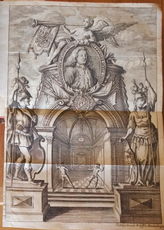|
|
You are not currently logged in. Are you accessing the unsecure (http) portal? Click here to switch to the secure portal. |
Codex 59-6-2
| Codex 59-6-2 | |||||
|---|---|---|---|---|---|
| 10.034, Fürstliche Sammlung Palais Liechtenstein Vienna, Austria | |||||
| |||||
| |||||
| |||||
| Also known as | N-6-15 | ||||
| Type | Fencing manual | ||||
| Date | 1715 | ||||
| Language(s) | Italian and German | ||||
| Author(s) | |||||
| Compiler | unknown | ||||
| Scribe(s) | Alexander Doyle and Francesco Alfieri | ||||
| Patron | Kurfürst zu Maynz | ||||
| Material | Paper, mondern binding | ||||
| Size | 272 pages à 227 x 152 mm (width x height) | ||||
| Format | Double-sided, with black and red ink | ||||
The Codex 59-6-2 is a 3 parts compiled fencing manual written in German and Italian. The original currently rests in the holdings of the fürstliche Sammlung des Palais Liechtenstein in Vienna, Austria.
The book has a hardcover of unknown material in brown colour. The materials of the three parts of the compendium is paper only and the dimension of the pages are also equal sized. There is no visible sign of cutting some pages, but it is obvious that the single books has been dismantled, because there happened some mistakes in the reassembling of the first part. Figure 10 disappeared totally and the figures 51 and 52 have been mixed up.
The book contains three different fencing manuals:
1. Alexander Doyle - Neu Alamodische Ritterliche Fecht- und Schirmkunst
2. Francesco Alfieri - A picca
3. Francesco Alfieri - La Bandiera
Neu Alamodische Ritterliche Fecht- und Schirmkunst
This codex was written in 1715 by Alexander Doyle an Irish fencing master in the services of the Kurfürst von Maynz (elector of Mayence) in German language. It treats in 60 plays the handling of the small sword and only the small sword. Play No. 10 is went missing during the reassembling of the compendium and fig. No. 51 and 52 has been inserted in the wrong order (52 before 51). Doyle wrote the book under the latest fashion of the french small sword tradition - at least he said so in his pretext where it is written "Das ist wahre und nach neuester Französischer Manier eingerichtete Unterweisung wie man sich in Fechten und Schirmen perfectionieren und verhalten solle: Denen respective Herren Liebhaberen zu besserer Erleuterung mit 60. hierzu dienlichen Figuren herausgegeben von Alexander Doyle aus Irland gebürtig. Ihrer Kurfürstlichen Gnaden zu Maynz verordneten Hof-Fechtmeistern"
Translation: This is the true and based on the latest French Design arranged instruction how someone should perfectionize and deal in fencing and protecting: Those respective (the fencing) loving gentlemen presented in 60 figures for their better understanding from Alexander Doyle born in Ireland. His electors grace of Mayence court fencing master.
Special for this book is the attached index register in which Doyle did list up all his figures titles and the page where to find it. Based on this index register the most amusing sounding "Dreyfache Finte" (triple feint) went missing.
A Picca
This part of the compendium was written by Francesco Alfieri in March 1641 for Count Ludwig von Ortenburg (a part Carinthia in Austria). Alfieri deals he only with the problems of "how to handle a pike". It is written in Italian and contains 16 chapters on 39 pages. It does not seem to be a fencing manual but an instruction how to handle, carry and hold a typical 17th century pike (length 5m and more). It ends with a "Conclusione dell'opera" with no index register at the end.
La Bandiera
This part of the compendium was also written by Francesco Alfieri in September 1638 and also for the Count Ludwig of Ortenburg. This book is also not a fencing manual, but an instruction for flag wavers. It is written in Italian and contains 28 chapters on 63 pages.

